 | |
| . | |
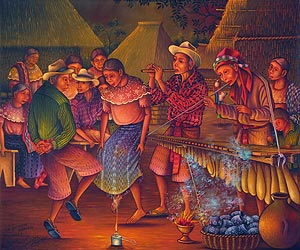 | |
| . | |
| . | [Current Exhibition] LINKS TO SECTION PAGES |
| . | |
 | |
| . | |
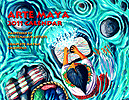 Twelve different Maya artists illustrates the months of the Arte Maya Calendar for 2011. The calendar includes the ancient Maya glyphs for each day of the year. Buying the calendar directly from us rather than other outlets helps the artists even more. We now have a postcard set that features paintings by six different Maya artists. Twelve different Maya artists illustrates the months of the Arte Maya Calendar for 2011. The calendar includes the ancient Maya glyphs for each day of the year. Buying the calendar directly from us rather than other outlets helps the artists even more. We now have a postcard set that features paintings by six different Maya artists.Currently the only reproductions we have, other than those in the calendar or postcards, are serigraphs and lithographs by Carlos Merida. Carlos Merida is probably the most famous artist from Guatemala. During the 1940s and 1950s did several series of prints of the traje(traditional dress) of the Indians of Guatemala and Mexico. | |
| . | |
| . | |
| In addition to the paintings in the galleries arranged by artist, there are nine other paintings that are in an exhibition in Berkeley which will last from October 1 to the beginning of January of 2011 year. | |
| This section is arranged by artist, but there are two section pages one with paintings under $150 and another with major paintings—those paintings which are large, took a month or more for the artist to paint, and are of the highest quality. There is also a new page where you can buy original paintings from the Arte Maya calendars. Until January 1, 2011, the paintings of Vicenta Puzul, Antonio Vasquez Yojcom, Domingo Garcia Criado, and Jose Antonio Gonzalez Escobar are 25% off. | |
| . | |
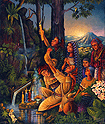 Pedro Rafael González Chavajay, Rafael's grandson, took up painting and became San Pedro la Laguna's second painter. Over time his painting developed a distinctive style and he was instrumental in defining the Tz'utuhil style of painting. Along with his cousin Mariano Gonzalez, Pedro Rafael is considered San Pedro's finest artist. In Guatemala he has the reputation as the best among the many autodidactic Mayan painters. Pedro Rafael has worked exclusively with Arte Maya Tz'utuhil since 1992. His paintings were shown with the blockbuster exhibition "Courtly Art of the Ancient Maya," and are in the permanent collection of the Smithsonian National Museum of the American Indian. Pedro Rafael González Chavajay, Rafael's grandson, took up painting and became San Pedro la Laguna's second painter. Over time his painting developed a distinctive style and he was instrumental in defining the Tz'utuhil style of painting. Along with his cousin Mariano Gonzalez, Pedro Rafael is considered San Pedro's finest artist. In Guatemala he has the reputation as the best among the many autodidactic Mayan painters. Pedro Rafael has worked exclusively with Arte Maya Tz'utuhil since 1992. His paintings were shown with the blockbuster exhibition "Courtly Art of the Ancient Maya," and are in the permanent collection of the Smithsonian National Museum of the American Indian. | |
| . | |
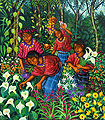 Mario Gonzalez Chavajay has been painting for nearly twenty years. He is one of two younger brothers of Pedro Rafael Gonzalez Chavajay who are painters. Mario perfected his technique painting for the local galleries catering to tourists. Four years ago he decided he wanted to paint original themes and now works exclusively for Arte Maya Tz'utuhil. His paintings are being shown with the blockbuster exhibition "Courtly Art of the Ancient Maya," and are in the permanent collection of the Smithsonian National Museum of the American Indian. Mario Gonzalez Chavajay has been painting for nearly twenty years. He is one of two younger brothers of Pedro Rafael Gonzalez Chavajay who are painters. Mario perfected his technique painting for the local galleries catering to tourists. Four years ago he decided he wanted to paint original themes and now works exclusively for Arte Maya Tz'utuhil. His paintings are being shown with the blockbuster exhibition "Courtly Art of the Ancient Maya," and are in the permanent collection of the Smithsonian National Museum of the American Indian. | |
| . | |
 Diego Isaias Hernandez started out working in colored pencils on paper. He graduated to sculpture but finally ended up becoming an oil painter. Wisely he decided to learn on his own with the result that he has developed an original style which still is uniquely Mayan. Among all of the Mayan painters he comes up with some of the most interesting titles for his paintings. He won first prize in Guatemala's most prestigious art competition for a painting entitled "Mitch" about the hurricane which passed through Central America cause much destruction and loss of life. Diego Isaias Hernandez started out working in colored pencils on paper. He graduated to sculpture but finally ended up becoming an oil painter. Wisely he decided to learn on his own with the result that he has developed an original style which still is uniquely Mayan. Among all of the Mayan painters he comes up with some of the most interesting titles for his paintings. He won first prize in Guatemala's most prestigious art competition for a painting entitled "Mitch" about the hurricane which passed through Central America cause much destruction and loss of life. | |
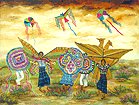 Paula Nicho Cumes is unquestionably the most important woman artist among the self taught Maya painters of Guatemala. She is a Kaqchikel Maya Indian from San Juan Comalapa, the other area with a concentration of Maya artists painting in a style that comes out of their own Maya culture. Paula Nicho Cumes is unquestionably the most important woman artist among the self taught Maya painters of Guatemala. She is a Kaqchikel Maya Indian from San Juan Comalapa, the other area with a concentration of Maya artists painting in a style that comes out of their own Maya culture. | |
| . | |
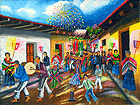 Maria Elena Curruchiche is the granddaughter of illustrious Andres Curruchich the first painter from San Juan Comalapa. Her father was also a well known painter. She and her cousin Rosa Elena Curruchich were the first women painters from Comalapa. (Yes, their last names are spelled correctly. The family added an "e" to the spelling.) Maria Elena Curruchiche is the granddaughter of illustrious Andres Curruchich the first painter from San Juan Comalapa. Her father was also a well known painter. She and her cousin Rosa Elena Curruchich were the first women painters from Comalapa. (Yes, their last names are spelled correctly. The family added an "e" to the spelling.) | |
| . | |
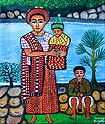 Lorenzo Gonzalez Chavajay died in 1996. He had taken up painting late in life and had only been painting for about seven years when he got sick and died. He is the only truly naive artist among the Tz'utuhil Maya painters. He was entirely self taught, and his style was completely his own. His works are at the same time naive and modern, Guatemalan and Maya. I know of no better naive Guatemalan artist. After I met Lorenzo I bought almost everything he painted. His paintings are now hard to come by, and this is the largest collection of his paintings to go on the market. Lorenzo Gonzalez Chavajay died in 1996. He had taken up painting late in life and had only been painting for about seven years when he got sick and died. He is the only truly naive artist among the Tz'utuhil Maya painters. He was entirely self taught, and his style was completely his own. His works are at the same time naive and modern, Guatemalan and Maya. I know of no better naive Guatemalan artist. After I met Lorenzo I bought almost everything he painted. His paintings are now hard to come by, and this is the largest collection of his paintings to go on the market. | |
| . | |
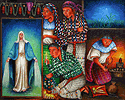 Domingo Garcia Criado is one of the few San Pedro artists to people his paintings almost exclusively with people wearing the traje of his pueblo—the other artists preferring the traje of the major tourist towns Santiago Atitlán and Chichicastenango. Domingo has stylized the designs on the traje and in nature to such a degree that his paintings while still naive have a definite op-art or art deco connection. The paintings of Domingo Garcia Criado are 25% off. Domingo Garcia Criado is one of the few San Pedro artists to people his paintings almost exclusively with people wearing the traje of his pueblo—the other artists preferring the traje of the major tourist towns Santiago Atitlán and Chichicastenango. Domingo has stylized the designs on the traje and in nature to such a degree that his paintings while still naive have a definite op-art or art deco connection. The paintings of Domingo Garcia Criado are 25% off. | |
| . | |
 Jose Maria Gonzalez Cox (Chema Cox) and his nephew Edwin Gonzalez create the most carefully detailed watercolors you can imagine. Their paintings are of the highest quality. The style of their paintings is not the Tz'utuhil Maya style of their community, but a style that comes from a European influence. Their paintings always, however, depict Maya traditions usually set in the grandeur of Nature. Jose Maria Gonzalez Cox (Chema Cox) and his nephew Edwin Gonzalez create the most carefully detailed watercolors you can imagine. Their paintings are of the highest quality. The style of their paintings is not the Tz'utuhil Maya style of their community, but a style that comes from a European influence. Their paintings always, however, depict Maya traditions usually set in the grandeur of Nature. | |
| . | |
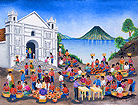 In the 1970's Jose Antonio Gonzalez Escobar travelled to the United States to exhibit his paintings with the other major painters of the time, his father and first Tz'utuhil painter, Rafael Gonzalez y Gonzalez, Juan Sisay of Santiago Atitlán and Andres Curruchich the first Kaqchikel painter from San Juan Comalapa. Jose Antonio's many years of painting have firmly established his position among the Tz'utuhil painters. Jose is one of only two Tz'utuhil painters who live in Guatemala City rather than on Lake Atitlán. Two now internationally famous Tz'utuhil artists, Pedro Rafael Gonzalez Chavajay and Mariano Gonzalez Chavajay, began their oil painting careers working with their uncle Jose Antonio. The paintings of Jose Antonio Gonzalez Escobar are 25% off. In the 1970's Jose Antonio Gonzalez Escobar travelled to the United States to exhibit his paintings with the other major painters of the time, his father and first Tz'utuhil painter, Rafael Gonzalez y Gonzalez, Juan Sisay of Santiago Atitlán and Andres Curruchich the first Kaqchikel painter from San Juan Comalapa. Jose Antonio's many years of painting have firmly established his position among the Tz'utuhil painters. Jose is one of only two Tz'utuhil painters who live in Guatemala City rather than on Lake Atitlán. Two now internationally famous Tz'utuhil artists, Pedro Rafael Gonzalez Chavajay and Mariano Gonzalez Chavajay, began their oil painting careers working with their uncle Jose Antonio. The paintings of Jose Antonio Gonzalez Escobar are 25% off. | |
| . | |
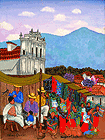 Margarito Chex Icú lives in San Juan Comalapa. His style is quite distinctive and typical of the his town. He typically paints festivals and market scenes of the various Maya communities he has visited. His paintings are brightly colored and feature the traje (traditional attire) of many towns that the Tz'utuhil Maya artists seldom paint. Margarito Chex Icú lives in San Juan Comalapa. His style is quite distinctive and typical of the his town. He typically paints festivals and market scenes of the various Maya communities he has visited. His paintings are brightly colored and feature the traje (traditional attire) of many towns that the Tz'utuhil Maya artists seldom paint. | |
| . | |
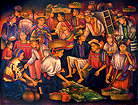 Probably the most famous artist from San Pedro la Laguna is Mariano Gonzalez Chavajay. Mariano along with Pedro Rafael Gonzalez Chavajay are the two most accomplished oil painters from San Pedro. Mariano's specialty is large paintings of Maya life and traditions. Probably the most famous artist from San Pedro la Laguna is Mariano Gonzalez Chavajay. Mariano along with Pedro Rafael Gonzalez Chavajay are the two most accomplished oil painters from San Pedro. Mariano's specialty is large paintings of Maya life and traditions. | |
| . | |
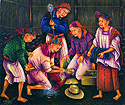 Vicenta Puzul de Gonzalez, the first Tz'utuhil woman oil painter, learned from her husband Mariano Gonzalez Chavajay. Vicenta has a natural ability. She learned quickly and well. Of all of Mariano's students she is the only one who can paint exactly like her husband. Her works are virtually indistinguishable from those of Mariano, except that her faces might be a little softer. For many years she relegated her painting to helping her husband, but in the last few years, with his support, has decided to paint on her own. The paintings of Vicenta Puzul are 25% off. Vicenta Puzul de Gonzalez, the first Tz'utuhil woman oil painter, learned from her husband Mariano Gonzalez Chavajay. Vicenta has a natural ability. She learned quickly and well. Of all of Mariano's students she is the only one who can paint exactly like her husband. Her works are virtually indistinguishable from those of Mariano, except that her faces might be a little softer. For many years she relegated her painting to helping her husband, but in the last few years, with his support, has decided to paint on her own. The paintings of Vicenta Puzul are 25% off. | |
| . | |
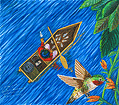 Juan Fermin Gonzalez Morales, is the eldest of three brothers who are painters. His work is distinctive because he usually situates his point of view from above. His paintings accurately capture the details of the way of life of Maya people, a way of life that is changing as the young people leave the villages for life in the city, and many traditions disappear. Juan Fermin Gonzalez Morales, is the eldest of three brothers who are painters. His work is distinctive because he usually situates his point of view from above. His paintings accurately capture the details of the way of life of Maya people, a way of life that is changing as the young people leave the villages for life in the city, and many traditions disappear. | |
| . | |
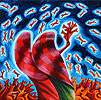 Emilio Gonzalez Morales is the second of the Morales brothers. He started out painting in the San Pedro style, but in recent years has stopped painting accurate depictions of Maya traditions and instead tries to capture their essence from a different point of view. Emilio Gonzalez Morales is the second of the Morales brothers. He started out painting in the San Pedro style, but in recent years has stopped painting accurate depictions of Maya traditions and instead tries to capture their essence from a different point of view. | |
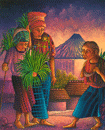 Miguel Angel Sunu Cortez is a young teacher from San Pedro la Laguna who has been studying painting with Pedro Rafael Gonzalaz Chavajay. He is the only Tz'utuhil Maya painter who paints more slowly than Pedro Rafael. Although part of the reason he paints slowly is his inexperience, the other part is that he is extremely careful and pays great attention to detail. He paints no more than five paintings a year so to have one of his paintings is to have a rarity. Miguel Angel Sunu Cortez is a young teacher from San Pedro la Laguna who has been studying painting with Pedro Rafael Gonzalaz Chavajay. He is the only Tz'utuhil Maya painter who paints more slowly than Pedro Rafael. Although part of the reason he paints slowly is his inexperience, the other part is that he is extremely careful and pays great attention to detail. He paints no more than five paintings a year so to have one of his paintings is to have a rarity. | |
| . | |
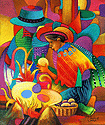 Julian Coche Mendoza, one of five brothers who are artists, is the only artist represented here who has gone to art school. He was obviously talented naive artist before he went to school, but once he left school he had trouble finding his path. After about ten years of experimenting in different styles, he began representing his Maya culture in a brilliantly colored style obviously influenced by cubism. His new style immediately became popular, and was copied by other Maya artists. Julian Coche Mendoza, one of five brothers who are artists, is the only artist represented here who has gone to art school. He was obviously talented naive artist before he went to school, but once he left school he had trouble finding his path. After about ten years of experimenting in different styles, he began representing his Maya culture in a brilliantly colored style obviously influenced by cubism. His new style immediately became popular, and was copied by other Maya artists. | |
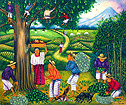 By 1990 Matias Gonzalez Chavajay was recognized as one of the best Tz'utuhil Maya artists. His paintings combined attention to detail with a naive charm. Then he decided to stop doing fine paintings and focus on doing paintings quickly for the tourist market. I stopped buying from him because the quality went down, but I recently decided that his work still is charming, even though quickly done. By 1990 Matias Gonzalez Chavajay was recognized as one of the best Tz'utuhil Maya artists. His paintings combined attention to detail with a naive charm. Then he decided to stop doing fine paintings and focus on doing paintings quickly for the tourist market. I stopped buying from him because the quality went down, but I recently decided that his work still is charming, even though quickly done. | |
| . | |
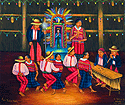 Maria Teodora Mendez de Gonzalez, the wife of Matias Gonzalez Chavajay, learned to paint to help her husband with the production of paintings for the tourist market. After they got their house built and their children's education paid for, Maria began doing paintings on her own and signing them herself. Because she worked so long on her husbands paintings, duplicating his style, her paintings are virtually indistinguishable, except perhaps by her interest in women's themes, from those of her husband. Maria Teodora Mendez de Gonzalez, the wife of Matias Gonzalez Chavajay, learned to paint to help her husband with the production of paintings for the tourist market. After they got their house built and their children's education paid for, Maria began doing paintings on her own and signing them herself. Because she worked so long on her husbands paintings, duplicating his style, her paintings are virtually indistinguishable, except perhaps by her interest in women's themes, from those of her husband. | |
| . | |
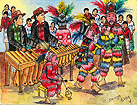 Juana Elva Vasquez de Ramirez and her husband Nicolas Ramirez run an art gallery in Santiago Atitlan. Almost lost among the oil paintings in the gallery are tiny watercolors done by the two of them. Juana Elva Vasquez de Ramirez and her husband Nicolas Ramirez run an art gallery in Santiago Atitlan. Almost lost among the oil paintings in the gallery are tiny watercolors done by the two of them. | |
| . | |
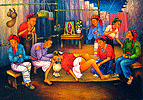 Antonio Vasquez Yojcom from San Juan la Laguna learned to paint from Pedro Rafael Gonzalez Chavajay. He began painting on his own in around 1992. Unlike the artists who began a few years after him, he has kept to painting original themes rather than repetitiously painting the three or so themes that are sold to tourists in Santiago Atitlan. The paintings of Antonio Vasquez Yojcom are 25% off. Antonio Vasquez Yojcom from San Juan la Laguna learned to paint from Pedro Rafael Gonzalez Chavajay. He began painting on his own in around 1992. Unlike the artists who began a few years after him, he has kept to painting original themes rather than repetitiously painting the three or so themes that are sold to tourists in Santiago Atitlan. The paintings of Antonio Vasquez Yojcom are 25% off. | |
| . | |
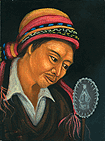 Felipe Batzin Navichoc of San Pedro la Laguna is the middle of three brothers who paint. His older brother Abraham well known in Guatemala. The faces of people done by Felipe are among the most realistic done by any of the artists in San Pedro. Felipe Batzin Navichoc of San Pedro la Laguna is the middle of three brothers who paint. His older brother Abraham well known in Guatemala. The faces of people done by Felipe are among the most realistic done by any of the artists in San Pedro. | |
| . |
skip to main |
skip to sidebar

Flag of Guatemala

Map of Guatemala

Lake Atitlan
This blog is meant to give a wide variety of information about Guatemala including news that indicates growing national invincibility through Vedic Knowledge programs as offered by Maharishi Mahesh Yogi. These include the Transcendental Meditation technique, the TM-Sidhi program, Vedic organic agriculture, Vedic architecture, the Maharishi Vedic Approach to Health, and other such programs to eliminate suffering and create Heaven on Earth.
Labels
- Civil War (3)
- Departments and Cities (14)
- Famous People (6)
- Geography (4)
- Good News (11)
- Government and Economy (14)
- Guatemala Overview (5)
- History (2)
- Indigenous People (19)
- Lakes and Volcanoes (11)
- Maps (3)
- Miscellaneous (23)
- Wildlife (4)
Recommended Websites
Flag of Guatemala

Flag of Guatemala
Map of Guatemala

Map of Guatemala
Lake Atitlan

Lake Atitlan